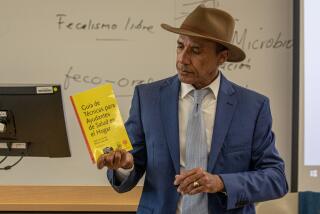BREA : Students Learning ‘Business Language’
- Share via
Students in Masako White’s class at Brea-Olinda High School can see the writing on the wall, but it isn’t easy to read.
Students learning Japanese in White’s class must learn a foreign alphabet that has twice as many characters as the English alphabet. And unlike French, Spanish and German--languages traditionally taken by high school students--Japanese shares no linguistic link with English.
So why did 29 students eschew the more familiar European languages for Japanese? The answer is as American as corporate takeovers and junk bonds.
Alex Miller, a 16-year-old sophomore, called Japanese “the business language.”
Many of Miller’s classmates agreed that learning Japanese is essential to their future. In September, White asked the students why they had chosen Japanese to fulfill the school’s language requirement. About half said they were taking the class because it would help them get ahead in business.
The importance of Japanese was also apparent to the Brea-Olinda Unified School District. When the class was proposed by a board member last school year, Assistant Supt. Pete Boothroyd was immediately enthusiastic. But finding a qualified teacher proved more difficult than Boothroyd anticipated.
After spending last summer searching for a Japanese teacher, Boothroyd finally turned to White, the parent of a student at the high school. “I asked her if she knew anyone who taught Japanese,” Boothroyd said.
White volunteered herself, telling Boothroyd she had taught on military bases, and the district approved a few days before the school year began.
White had few resources to turn to when planning the curriculum. Brea-Olinda is one of only two schools in the county to offer Japanese--Troy High School in Fullerton has offered the class for three years--and textbooks are also scarce, White said.
While acknowledging the practical aspect of learning Japanese, White hopes her students learn more than just her native language. To give them a better sense of Japanese culture, White arranged for the students to witness and participate in a tea ceremony, a ritual that has roots in the Zen movement.
More to Read
Sign up for Essential California
The most important California stories and recommendations in your inbox every morning.
You may occasionally receive promotional content from the Los Angeles Times.













